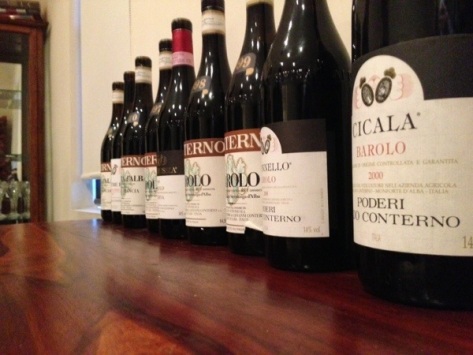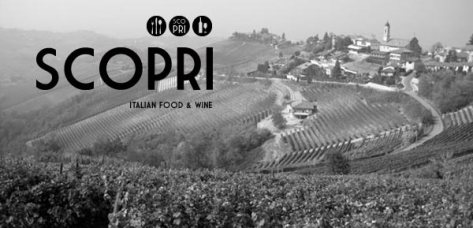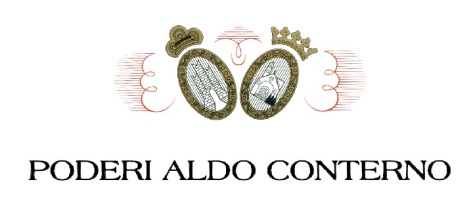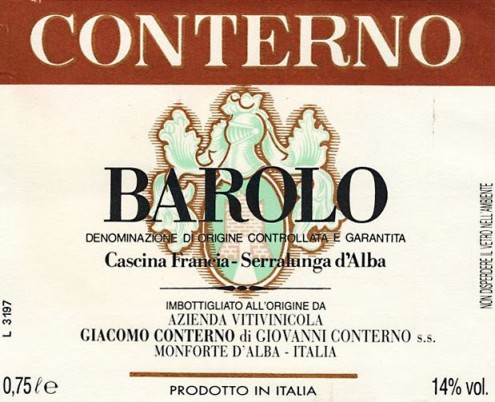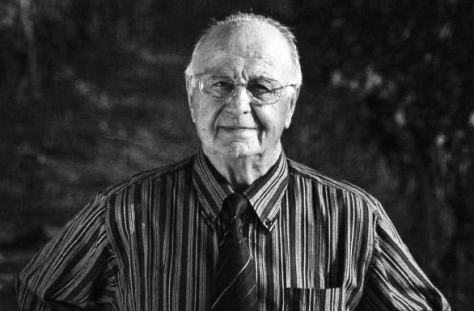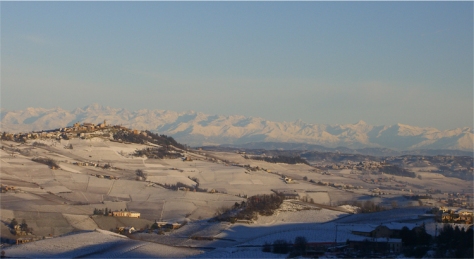
Over the last two years I have been lucky to have a fellow group of Italian wine lovers that wanted to drink the great wines of Italy and we have structured each dinner along a certain theme or producer. It is now at the stage where demand for a spot for these dinners is so great, that the limited spots available fill up in a matter of hours.
The wines either come from my cellar in Italy or cellars of individuals who attend the dinners. Last week we looked at a decade of Bartolo Mascarello Barolo, next month it is a decade of Giacomo Conterno Monfortino and in September, twenty vintages of Produttori del Barbaresco Barbaresco. Talk about educational.
There is nothing like sharing great bottles with friends over dinner and last week we shared many great bottles. Apart from the 1999 and 2011 which weren’t great bottles (but I would still happily drink them if on my own) the line up overall was of a very high standard. These are the best of the best. Rare collectors items and it is good to see them drunk rather than hung on to.
Below are some brief notes by myself on the wines. I have also listed Antonio Galloni as a comparison and sometimes with these wines, it is more about the bottle than the wine.
Reviews by Antonio Galloni to give you another perspective of the wines and my comments in italic’s on the wines:
Bartolo Mascarello Dolectto 2012
The 2012 Dolcetto d’Alba is drop-dead gorgeous. Dark cherry, plum, violets and lavender all flesh out in a soft, supple Dolcetto laced with expressive dark red/purplish fruit. Mascarello’s Dolcetto can sometimes be a bit austere and compact, not the 2012. It is stunning, classic and utterly delicious. 2014 – 2019 91 points Antonio Galloni
Upfront and perfumed, lovely weight and structure. A wine to drink young and enjoy the yummy upfront fruits.
Bartolo Mascarello Langhe Nebbiolo 2010
Readers who want to get a sense of the quality of the 2010 vintage in Barolo should check out the estate’s 2010 Langhe Nebiolo, which is essentially one cask of declassified Nebbiolo entirely from Barolo-designated vineyards. Sweet, perfumed and utterly gracious, the 2010 is all about grace and finesse. Layers of expressive Nebbiolo fruit flow through to the effortless and hugely inviting finish. 2013 – 2020 89 points Antonio Galloni
Structured and intense, just starting to enter it’s drinking window with upfront typical Nebbiolo fruits and still with enough acidity to see it continue to improve in the short term.
Bartolo Mascarello Langhe Nebbiolo 2011
Mascarello’s 2011 Langhe Nebiolo is one of the great, hidden gems in Piedmont. Freshly cut flowers, rose petals, sweet red berries and mint are all woven together in a wine of impeccable balance and total class. The 2011 is at once delicate and perfumed, but also has an extra level of richness from the warm vintage. The Langhe Nebiolo (note the traditional spelling with one ‘B’) is made from pre-selection of fruit taken in the vineyard and destined for a shorter fermentation/cask aging regime in the cellar. 2014-2021 92 points Antonio Galloni
Riper in colour and more developed than the 2010. A bigger wine but not better than the 2010. I would drink this whilst waiting for the 2010 Langhe Nebbiolo to come round.
Bartolo Mascarello Barolo 1999
Medium red. Mascarello’s 1999 Barolo is a brilliant effort, offering a perfumed, elegant nose and lovely notes of red cherry fruit, menthol and minerals that flow onto the palate in a display of extraordinary purity. As it sits in the glass subtle notes of earthiness and tobacco appear, the fruit becomes more ethereal, and the wine changes from its initial impression of power to more understated, nuanced expression of Nebbiolo. Deceptively medium bodied, it also has the structure to age well, and will still be a compelling Barolo at age 30. As has been the case in recent vintages I find more bottle variation than I would like, but this was the finest of the three bottles I tasted. 2013+ 93 points Antonio Galloni
Not a great bottle of 99 and already showing signs of oxidation. Storage is not an issue (climate controlled since release) so obviously a cork issue when you compare to Antonio Galloni’s notes.
Bartolo Mascarello Barolo 2000
After many years I have finally concluded that Bartolo Mascarello’s 2000 Barolo will always remain a mystery to me. From bottle, the 2000 Barolo has never been satisfying. I have gone through a number of bottles, mostly from my own cellar, and been consistently disapointed. As the wine has aged the ever present rustic bouquet has developed but not disappeared. Autumn leaves, mushrooms, dried cherries, tobacco and faded roses are some of the nuances that emerge from the glass. The unpolised qualities reappear on a finish marked by hard tannins. 2013-2020 86 points Antonio Galloni
Oddly enough, from magnum, the 2000 Barolo is magnificent, with none of the imperfections I have found in so many of my bottles. The wine shows considerable 2000 personality in its warm, radiant fruit, but the large format has maintained freshness and verve. Readers who can find the 2000 in magnum will want to consider the wine. 2013-2025 96 points Antonio Galloni
A surprise packet and showing extremely well. In the first stages of it’s drinking window, it is complex and unforced with beautifully rounded fruit and the structure to hold this length for many years to come.
Bartolo Mascarello Barolo 2001
Barolo remains one the most quirky and idiosyncratic wines on the market. Initially soft and delicate, it offers a lovely core of open-knit, expressive macerated cherries, raspberries, spices, tar, freshly ground coffee beans and earthiness, giving the impression of being fairly ready to drink. With air, multiple tastings reveal a wine that has put on considerable weight, completely changing its personality to a big, structured Barolo supported by plenty of acidity and tannins to age. Though it freshened up considerably over time, it never became completely clean. At once highly compelling yet frustratingly flawed, it will appeal to readers who can look past its funky notes. That said, several recent bottles have been outstanding so I have upgraded my score accordingly. 2013-2026 92 points Antonio Galloni
Like the 1999 this bottle was not a great example of the 2001 Mascarello Barolo. Hints of brett on the palate has stripped back some of that fruit leaving a wine that does not show it’s full potential.
Bartolo Mascarello Barolo 2003
Sweet tobacco, dried flowers, mint, and dried herbs meld together in the 2003 Barolo. The aromas have just begin to develop hints of tertiary complexity and nuance, while there is more than enough depth to support another decade of very fine drinking. The 2003 doesn’t have the finesse or polish of the best vintages, but it has certainly held up well. Exceptionally well. 2013-2024 92 points Antonio Galloni
Probably the surprise packed of the night. Beautiful wine. For a vintage like 2003, which was one of the hottest on record in Barolo, this is a sensual, delicately poised wine that still has plenty left in the tank. A wine that shows you not to generalise vintages when you have masters like Mascarello in control.
Bartolo Mascarello Barolo 2004
Her pure, finessed 2004 Barolo offers a compelling array of perfumed violets, dark cherries and baking spices with superb clarity and delineation. A weightless, ethereal Barolo, it reveals notable freshness and supple tannins on the long, finessed finish. Although I have tasted this wine many times from cask, I first encountered it from bottle at a blind tasting where it was immediately recognizable for its style, purity and class. This is the best young Barolo I have tasted here in many a year. Fans of traditional Barolo won’t want to miss this superb effort. The 2004 Barolo was fermented for 20-30 days in cement. The malos progressed at an unusually slow pace and weren’t finished until the following summer. The wine was aged in medium-sized casks. Readers can also look forward to promising wines in 2005, 2006 and 2007. I also had a chance to re-taste the 2003, which is a lovely Barolo for nearer-term consumption. 2014-2029 95 points Antonio Galloni
Close to perfection and the reason why Mascarello is held in such high esteem. Long, layered, unforced, complex and etheral. Still with decades in front of it, yet drinking so well from a young age.
Bartolo Mascarello Barolo 2005
The 2005 Barolo is super-delicate and finessed. This is a decidedly restrained, feminine style of Barolo laced with roses, raspberries, jasmine and berries. It will be fascinating to see which direction the 2005 takes from here. At times the wine appears to be putting on additional weight, but it nevertheless retains an element of frailty that is actually quite attractive. I rate the 2005 just behind the 2004, 2006 and 2007, but it is a gorgeous wine, and easily one of the very finest wines of the vintage. 2013-2025 95 points Antonio Galloni
Another fantastic Mascarello, not in the same groove as 2004 but in terms of quality, this is a very fine Barolo. It is still a few years away from entering it’s drinking window, but once it does arrive, the future is bright for this wine.
Bartolo Mascarello Barolo 2006 (Magnum)
Mascarello’s 2006 Barolo boasts great purity and density in a round, harmonious expression of fruit that emerges from a mid-weight frame. Silky tannins frame the intensely fragrant, dark red fruit as this exceptionally elegant, refined Barolo shows off its pedigree. The finish is long, clean and refreshing, suggesting the wine has many years of very fine drinking in store for readers who are lucky enough to own this bottle. Proprietor Maria-Theresa Mascarello describes 2006 as a hot year. The Nebbiolo harvest here began earlier than normal, on the 23rd of September, the same as 2005. That said, the 2006 Barolo has retained the classic, mid-weight style that readers have come to expect from Bartolo Mascarello. 2016-2031+ 96 points Antonio Galloni
Wow. Up there with the 2004 in that it is close to perfect for a young Barolo. This wine is going to have a very long future ahead of it and already the complexity and class of this wine is obvious. This wine also highlights the quality Maria-Theresa Mascarello possesses and even with a generational change, the quality at Mascarello has never been higher.
Bartolo Mascarello Barolo 2007
Mascarello’s 2007 Barolo flows from the glass with masses of round, enveloping fruit. This is an unusually soft, juicy Barolo from Mascarello that is remarkable for its textural richness and warm radiant fruit. The 2007 doesn’t have the aromatic complexity of the 2005 or 2006, but it makes up for that with its totally seductive personality. Crushed flowers, berries and sweet baking spices linger on a generous finish that evokes memories of the 1990. 2017-2032 96 points Antonio Galloni
This wine is a product of the year but like the 2003 Barolo, it has handled the extreme heat conditions far better than most other producers. This wine is already on the front foot, without the tannin structure of classic years. It is a wine for those that prefer to drink Mascarello sooner rather than later.
Bartolo Mascarello Barolo 2008
All is forgotten once the audience tastes Maria-Theresa Mascarello’s 2008 Barolo. The room is totally silent. That is usually a good sign. A totally spellbinding wine, the 2008 is flat-out stunning from the moment it emerges from the glass. The fruit is sweet, layered and haunting in its beauty, while the tannins are remarkably polished. This is a perfect example of the new paradigm in Barolo; today’s wines just don’t need decades to come around anymore. I bought these bottles ex-cellar and brought them back to US myself. What a difference that makes. The 2008 Mascarello is simply dazzling. If you can find it, don’t hesitate. 2018-2048 98 points Antonio Galloni
Whilst not showing at this young wine as the 2004 and 2006, there is no denying that this will join these wines in Barolo greatness. So young but if you hold into your wine in the glass long enough, it slowly opens up to show the enormous potential that is possesses.
Bartolo Mascarello Barolo 2009
Bartolo Mascarello fans will want to stock up on the 2009 Barolo, a great choice for indulging in pure pleasure while vintages like 2006, 2008 and 2010 take their time to develop in bottle. Dried rose petals, fennel, anise, sweet tobacco and mint are all very much alive in the glass. The 2009 is ethereal, graceful and utterly beguiling from the very first taste. I expect the 2009 will mature relatively quickly by the estate’s standards, but there is more positive to that than negative. 2014-2029 94 points Antonio Galloni
A fantastic Mascarello but without hitting the high notes of the previous vintage. Slightly forward and a good example of vintage variation with a typical Mascarello house style.












